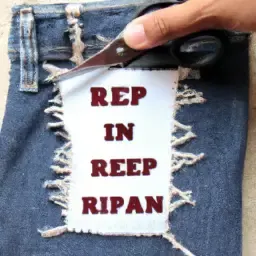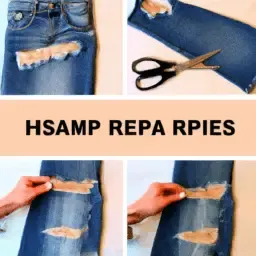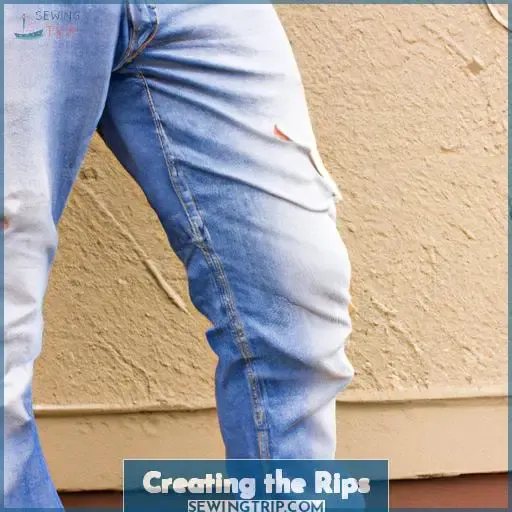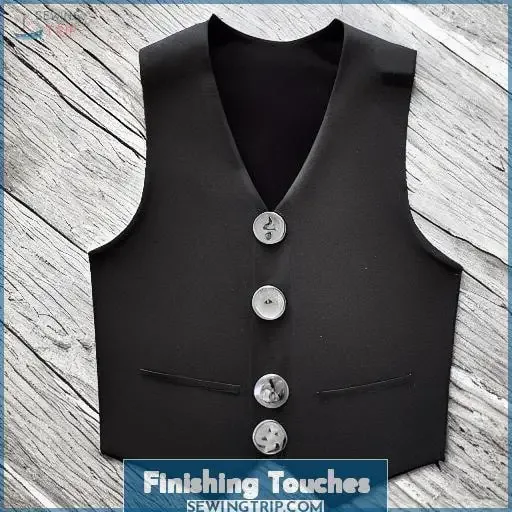This site is supported by our readers. We may earn a commission, at no cost to you, if you purchase through links.
Ripped jeans are a fashion staple that’s been popular amongst celebs and street style stars for decades. Over 60% of adults have owned at least one pair in the last five years! If you’re looking for an easy way to customize your denim wardrobe without breaking the bank, you’re in the right place.
This guide will show you how to make rips in your own jeans so they look as authentic as possible.
We’ll cover:
- Choosing the perfect pair of jeans
- Supplies needed
- Creating stylish rips
Get ready for some serious DIY fun!
Table Of Contents
Choosing the Right Pair of Jeans
When it comes to ripping your own jeans, pick something that will work best for the look you’re going for. Whether that’s tight and skinny, boyfriend style, black, white, or blue; high-waisted or mid-rise. Once you’ve found the right fit, wash them in hot water with some bleach if you want an extra worn look.
1 Type of Jeans
Decide whether you want a tight and skinny silhouette or a relaxed, boyfriend-style fit to begin your DIY ripped jeans journey. You can also choose between fading jeans with frayed hems, pocket holes for added texture, distressed patches on the thigh area or ripped seams around the knees.
If sewing isn’t an option, use tools such as pumice stone and sandpaper to distress any pair of jeans before cutting them with an X-Acto knife into desired shapes. With this method you have full control over where each rip will go and how big they’ll be – so it’s easy to customize your look!
2 Color of Jeans
Choose the color of jeans that will best show off your unique style – whether it’s a classic blue, a bold black or an eye-catching white.
When deciding which denim to use for your ripped jeans project, consider cutting technique, thread selection and stitching patterns; distressing techniques such as steel wool and sandpaper; hole size and placement; type of thread (white threads stand out more); sharp knife or small wooden block for shredding details.
With these tools in hand you can craft ripped jeans with precision and creativity!
3 Fit of Jeans
Once you have chosen the perfect pair of jeans for your project, it’s important to ensure they fit properly. Consider sizing options like tight and skinny or boyfriend style, black, white or blue denim in high-waisted or mid-rise styles. Think about material selection based on the level of distressing desired and price range. When choosing a brand, keep in mind their reputation for quality denim products. Hem length should be considered if you plan on cutting off excess fabric.
Creating the distressed look? Use sandpaper and paint-removing block before using fabric scissors to create small holes at marked areas on knee or butt area sections. If skin isn’t desired all the way through rips, use tweezers to fray them. For an authentic worn-out appearance, soak them first and wash multiple times in hot water. This will give better control over placement size scope tears than buying pre-distressed alternatives without compromising comfort!
Supplies You Will Need
Get creative and take control of your style with the right supplies to make those rips look just how you want them! Start by choosing a pair of denim jeans that fit well and measure it to get an idea of where to place the rips.
Gather all the tools: sandpaper, an X-Acto knife or box cutter, small block of wood or cutting board for protection when cutting through fabric patches, and some fraying fabric for extra distress levels if desired.
Mark where you plan on making the cuts with a pen or chalk, then place them onto a flat surface such as a cutting board. Make sure each hole is carefully cut with precision; use sharp scissors instead of dull ones to avoid mistakes and create perfectly distressed holes.
Start distressing different areas like knees and butt area by rubbing sandpaper against them until they thin out for an authentically ripped look.
Add threads around openings giving it more texture—you’ve got yourself custom-made DIY ripped jeans now!
Marking the Areas to Rip
Wearing your jeans is the best way to determine where you want the rips and tears. Create lines with chalk or a pen, then mark where you’ll cut holes. Use a ruler if necessary; it gives more precision when marking areas that need extra wear or tear.
Have fun while creating custom-made ripped jeans. DIYing allows maximum control over placement, size, and scope of each rip!
1 Wear Your Jeans
Now that you’ve got your custom-ripped jeans, it’s time to show them off! To make sure they look their best, wear the jeans for a few hours before fraying the edges. This will help set in any leg length or denim quality alterations and give an idea of how different style variations (pocket shapes) might look.
While wearing them, use sandpaper on small sections of the fabric over a kitchen table to get that worn-in and frayed look. Once done, regular scissors and tweezers (for smaller areas needing more precision work) can be used.
With these tools and techniques, plus patience, anyone can create unique ripped jeans perfect for every season!
2 Create Lines
Now it’s time to create the lines for your custom-distressed denim – grab some sandpaper and get ready to give those jeans a worn-in look! Using patches, threading techniques, and loose hems can help you achieve the desired ripped effect.
If you’re looking for an extra bleached out look, try using different bleaching techniques. You can also use this opportunity to be creative with unique custom designs or go with a classic style of medium wash jeans that will have stringy patches when distressed on a flat surface.
To finish off your masterpiece make sure all edges are finished by hand stitching them together using blue-colored thread and if needed place cardboard underneath so that no holes appear through both sides of fabric.
3 Mark the Holes
With your sharp scissors or X-Acto knife, carefully mark the area where you want to create holes for maximum distressed effect – like a star athlete scoring points on the court! To get an authentic faded jeans look, consider sewing patches over areas of distress and fading. Alternatively, use sandpaper to thin out parts of denim and make them more susceptible to ripping. This will also help achieve a truly distressed look in those hard-to-reach areas such as knees of jeans.
When it’s time to cut into your fabric for creating widths in your holes that fit with the overall aesthetic you’re going for – stack up some magazines or place a piece of cardboard inside so when you cut through both layers at once it doesn’t ruin whatever’s underneath!
Creating the Rips
Ready to turn those boring jeans into something you’ll love? With a few simple supplies and some careful crafting, you can create the perfect ripped look.
Start by using sandpaper to distress the denim where your rips will go – then switch to steel wool for added texture. Once it’s thinned out enough, grab your scissors or sharp knife and start cutting away!
To get even more precision with each rip, try placing a small block of wood underneath while using the cutting board as protection on top – add just a little bit of water too before running over them again with sandpaper.
Finish off by adding extra dimension with scissors and pumice stone at any desired spots! You’ll be rocking that unique style in no time!
1 Use Sandpaper
To achieve a distressed look, sandpaper the areas you want to create holes in for maximum effect! Sandpaper techniques vary depending on the ripped style desired. Abrasive materials like steel wool and pumice stone can thin out denim fabric or give it an aged appearance before cutting. To fray edges of new jeans, use a piece of cardboard between layers of fabric and rub with sandpaper until they start fraying.
When distressing cheap jeans from thrift stores like Salvation Army, wash them first in hot water with little detergent for best results before using abrasive methods like sandpaper rubbing. This’ll help make sure that all rips are even throughout your jeans giving you an authentically ripped look!
2 Use Steel Wool
To get an even more distressed look, rub the areas you want to fray with steel wool! It’ll help lessen any imperfections from ironing holes into your jeans. It’s a great way to create natural rips and achieve the fashion-favorite frayed edges that street style stars love. With the right tools and DIY process, you can easily master this distressing technique for a perfect pair of ripped jeans!
3 Use Scissors
Grab your scissors and start snipping away at the marked areas to create a unique, stylishly distressed look. Carefully fray fabric around holes with your scissors for an added touch of texture. Patching up the holes is recommended for better results—just make sure you use denim-colored thread that matches the color of your jeans!
Don’t forget to distress other parts like hemline alteration or distressing specific areas using sandpaper, steel wool, and pumice stone—this will give a more authentic look.
As personal stylist Paola Farina suggests: If you’re going for smaller holes in tight spots, opt for sharp embroidery scissors instead.
Before starting any project involving DIY ripped jeans, always remember proper denim care—pre-washing helps remove chemicals used during manufacturing as well as reduces bleeding when you cut them up later on!
4 Use a Sharp Knife
To get the perfect distressed look, take out a sharp knife and carefully cut the marked areas. Caution is key when handling any type of knife, as it could cause serious injury if not used properly.
Ripped jeans have been in fashion since the 80s and are now part of the grunge fashion movement. This guide will help you create your own designer pair from an old book or piece of cardboard, for a fraction of the cost you’d pay at a store!
Whether your style is tight & skinny or boyfriend fit, high-waisted mid-rise, black denim styling with white frayed edges, follow these steps to make sure each rip looks perfectly placed on each side!
5 Use a Small Block of Wood
To give your rips a more authentic look, use a small block of wood to rub and distress the fabric. Thrifting tips can help you find inexpensive jeans for DIY projects. Embellishment ideas like patches or hemline variations add character to ripped jeans; patch repairs are also an option if you want to restore some of the original fabric. Distressed techniques like sandpaper, steel wool, and pumice stones create a frayed chic look when used on dark washed jeans with large chunk rips.
To make smaller holes in denim without completely cutting through it, try using pieces of cardboard or even better – a small block of wood – as these materials will provide enough pressure while preventing you from making permanent cuts in your material.
6 Use a Cutting Board
To create the perfect rips in your denim, use a cutting board. It’ll provide pressure and ensure precision while you cut. This’ll help reduce fraying and add patches that fit right into the kind of style you’re looking for.
Grinding jeans takes time and patience, but comes at a heavy price due to its classical studies approach. Abrasion options are also available, but they require more effort and take longer to achieve the desired look or effect.
If you want quality results in less time, investing in an appropriate cutting board is definitely worth it!
7 Use a Little Water
To give your jeans a worn-in look, spritz ’em with water and use sandpaper or steel wool to rub it in – just like you’re gently buffing away a layer of dust. Ironing techniques can be used to fade the color and repair small holes, while fraying threads or creating raw edges adds those subtle touches.
Put a piece of cardboard inside before doing any little DIY action with faded spots or rips. This way, you’ll have complete control over how much distress appears on each pair of denim pants!
Ironing, buffing, fraying and ripping – it’s all the same to your jeans. With just a little water, you can make all the difference!
8 Use Sandpaper Again
After you’ve finished ironing, buffing and fraying your jeans, use sandpaper once more to add authentic-looking rips. Select a piece of sandpaper that’s coarse enough to create an abrasive action but not so rough it’ll damage the fabric. Alternatives like steel wool or a pumice stone work too, if you want less intense distressing. When using sandpaper on darker shade jeans, place a piece of cardboard inside so you don’t get scratches on the other side.
Begin by rubbing at strategic areas like knees and butt for distressed looks, worn by models Gigi Hadid and Kendall Jenner. This will thin out those areas while creating holes in some spots too. Do this slowly until you get the desired effect. Then cut any extra holes if necessary. Moving around, treading lightly over sections with some pressure can do wonders.
Try different effects like rubbing along seams or crossing motions across multiple layers. This will get you various styles – from subtle fading effects, à la Kim Kardashian West’s look, all the way up to full-blown ripped creations, modeled after Selena Gomez’s style.
Have fun experimenting and trust yourself when making decisions about what works best for your own design aesthetic!
9 Use a Pumice Stone
Gently rub the pumice stone over your denim to give it a worn-in, distressed look. Selena Gomez and Kim Kardashian both rock this style, so patch up hems and seams for a unique look. Get a cardboard template for raw edges and use the pumice stone for frayed rips. Start with light pressure, then use scissors or a knife for a final cut. With practice and patience you can DIY the perfect ripped jeans for any occasion!
10 Use Scissors Again
To finish off your distressed denim look, take out those scissors one more time and snip away at the fabric for a truly customized pair of jeans. A good starting point is to place a piece of cardboard inside your jeans so you don’t tear through both sides when cutting holes. You’ll need a pair of super-sharp small scissors or an X-Acto knife to get the job done properly without fraying too much.
Start by creating some loose threads by lightly pulling on them in different directions using tweezers. Then, use your tool of choice (scissors or X-Acto knife) with careful precision around hems, seams, pockets etc., creating intentional tears while avoiding any unintentional fraying throughout other areas such as knees and waistband where distressing already exists due to wear & tear over the years.
Don’t forget to add those extra details like breaking up larger rips into smaller ones along edges or even stressing out hems further with sandpaper for added depth. These final touches can really make the difference between an amateur looking DIY project ripped jeans and a custom tailored designer quality distressed denim masterpiece!
Finishing Touches
If you want to give your jeans a distressed look, wash them in hot water and bleach. This will help manage the rips pre-distressed denim usually has. Use sandpaper, steel wool, or a pumice stone to add more of an aged appearance. Cut holes carefully, paying special attention to the pockets and knees. With some careful planning, patience, and effort, you’ll have a stylish pair of customized ripped jeans!
1 Wash Your Jeans
Start your project off right by washing your jeans in hot water and bleach to give them a worn-in look! Whether you’re going for an ultra stylish, distressed look or just want a faded, edgy look of the first Italian institute, washing is the key.
Soak the jeans in hot water with 1/2 cup of bleach before putting into a washer machine. This helps fade out blue threads and create more texture around each leg of the pants. Use cold water after one to two washes as this will help set color fading process.
For extra protection against fabric stretching, place a piece of cardboard inside each leg while still damp from the wash cycle prior to ironing or drying flat naturally.
2 Manage the Rips
Take control of your style and make a statement by managing the rips in your jeans! To achieve distressed denim that looks authentically ripped, start with adding patches over stretching or patching holes. For added texture and an extra-worn look, use sandpaper to distress the fabric before cutting any holes.
With a pair of super-sharp small scissors, carefully cut around the perimeter of much-loved pieces of clothing for finished product fraying edges along them to give it an image fashion worthy finish. This will help you create the exact ripped design you want for every single piece, while making sure each rip is unique from one another so no two pairs are alike!
3 Add More Distressed Look
Give your jeans an edgy, unique look by adding more distressed details for a truly customised style! Fading them is the most common technique used to give them that fashionable, trendy look. To do this, you can use bleach or sandpaper on the areas you want faded. Sew patches onto any worn-out spots for extra flair. Frayed edges and fraying hems are another way of giving your denim that vintage vibe with minimal effort.
Shredding denim is easy and looks great if done correctly. All you need is a piece of cardboard, scissors, and patience. Use sandpaper or steel wool on distressed areas to make sure those rips stay looking their best.
Get ready for compliments as soon as you step outside wearing those one-of-a-kind ripped-up jeans. They’ll turn heads wherever you go!
4 Manage the Pocket
Give your jeans a personalized touch by managing the pocket – add frayed edges for an instantly stylish look!
As with any fashion trend, denim styles go through phases of wear and usage. To achieve that distressed effect, you need to plan.
Use the half rule; find the center point between each side seam and mark it as a guide for fraying.
Have a pair of super-sharp small scissors or an X-Acto knife ready to cut away. Place some cardboard behind where you want to cut, so as not to damage other areas of the jean.
Cutting around curves like pockets can be tricky but don’t worry too much about perfection – it adds character!
Focus on one area rather than all-over distressing, such as adding tears along seams near knees or cuffs.
Use this table for inspiration when deciding what type of denim style pairs well with ripped looks, based on how often it will be worn (daily vs. casual). Consider colors such as black, white, or blue, too – they can affect how often the pieces get worn.
When it’s time to finish off those edgy cuts around back pockets? Slip cardboard underneath them first, before snipping away. This prevents unwanted holes from forming elsewhere due to overzealousness or lack of attention to detail during the distressing phase.
5 Manage the Knees of Jeans
Take control of your style and get ready to take a walk on the wild side – it’s time to give your jeans some knee-high love.
Grab a great deal – an old pair from a thrift store or one lying in your closet will do! Equip yourself with a piece of cardboard (to protect other layers) and super-sharp, small scissors – essential for this kind of work.
Start by cutting along the fabric lines using scissors until desired effect is achieved. Then, create hem repairs, and more intricate details such as new kids, if desired.
You’ll be surprised how easily you can give an entirely new look to an ordinary pair, and have fun at the same time!
Frequently Asked Questions (FAQs)
How should I launder my ripped jeans?
Having a pair of ripped jeans is all the rage these days. But if you don’t want them to fade or get too distressed, it’s important to know how to launder them properly.
You can start by using a gentle cycle in the washing machine and avoiding any harsh detergents with bleach techniques. For more detailed thread repair jobs and styling tips, hand-washing is best, as this will give you full control over patchwork designs.
If your already-distressed denim becomes damaged further due to wear or tear, use a pair of super-sharp small scissors along with a piece of cardboard for protection when cutting away loose threads or fabric patches that need replacing.
Although laundering your ripped jeans may sound intimidating – almost like having too much money, or what some call a champagne problem – following our version of this article should make it easy!
What type of fabric is best for DIY ripped jeans?
When it comes to DIY ripped jeans, the most important step is selecting the right fabric. Durability and customizing style are key components; choose a tight and skinny or boyfriend style, black, white or blue for your desired look.
To ensure you can control rip sizes and distressing techniques, go with optimal quality fabric that’ll hold up under pressure when sanding down areas where rips will be made.
Once you’ve chosen the perfect pair of denim, take out a piece of cardboard and a pair of super-sharp small scissors; these tools are essential in creating precise cuts for authentic-looking holes without skin showing through!
With this combo in hand, all that’s left to do is start ripping away at those jeans with confidence – little by little until they’re ready to flaunt!
Can I use bleach to distress the denim?
Yes, you can use bleach to distress the denim for DIY ripped jeans! Take safety precautions when handling chemicals, such as gloves and proper ventilation. Adding a bleaching technique is an effective way of creating more distressed styles than just cutting holes. Choose quality denim fabrics that won’t fray too easily during the distressing process. That way, you’ll have stylishly-ripped jeans that will last.
How can I make sure the rips look even?
Tailoring your jeans to have even rips can be daunting, but with the right fabric selection and techniques, it doesn’t need to be. Choose a sturdy material like 100% cotton or raw denim for fades that won’t wash away too quickly.
Use sharp scissors or an X-Acto knife on the marked areas, using a ruler for accuracy if needed. Then tear them further manually with sandpaper or steel wool.
Fray the threads of desired holes to create dimension in the rip and hold its shape over time. This will let you craft unique pieces just for you!
Are there any safety considerations when making rips in jeans?
When making rips in jeans, there are several safety considerations to keep in mind. Use protective gear such as gloves and eye goggles when using sharp objects like scissors or an X-Acto knife. Sewing techniques should be employed if you want the rips more permanent and secure.
Be aware of the denim weave so you don’t cut too deep, and distressing methods can help ensure your work looks even throughout. Making sure these safety measures are taken will ensure a successful DIY project!
Conclusion
Making rips in your jeans is an easy DIY project if you have the right tools and supplies. Control size and placement for a unique look. Take it one step at a time and don’t be afraid to experiment. I recently tried to make a rip much larger than I anticipated. Instead of throwing them away, I added more distress and now they’re my favorite pair. The end result is a unique pair no one else has. Don’t be afraid to make mistakes and have fun with it!











